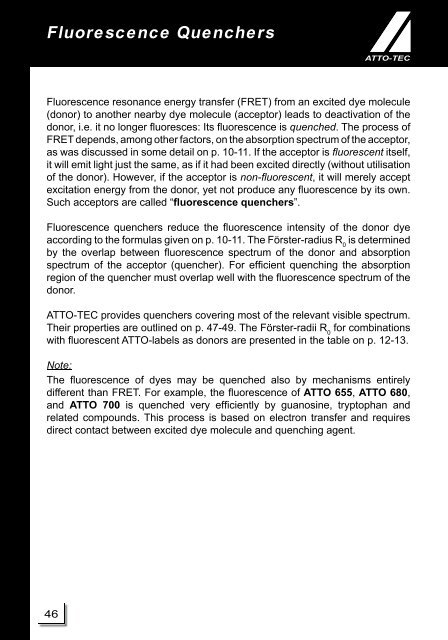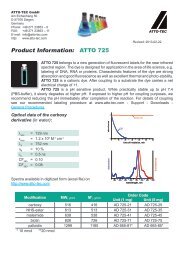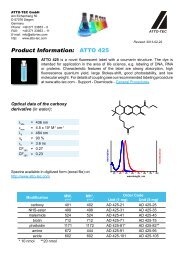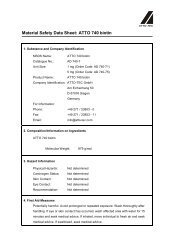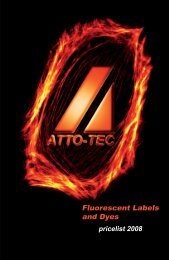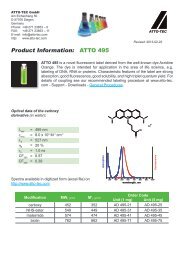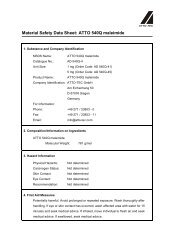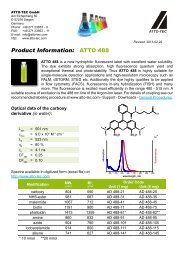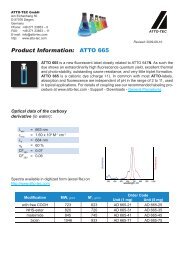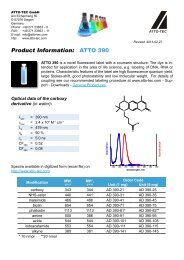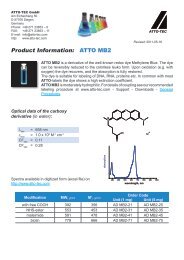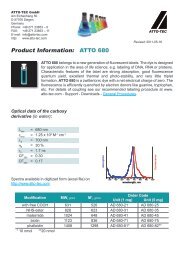Fluorescent Labels and Dyes - ATTO-TEC GmbH
Fluorescent Labels and Dyes - ATTO-TEC GmbH
Fluorescent Labels and Dyes - ATTO-TEC GmbH
Create successful ePaper yourself
Turn your PDF publications into a flip-book with our unique Google optimized e-Paper software.
Fluorescence Quenchers<br />
Fluorescence resonance energy transfer (FRET) from an excited dye molecule<br />
(donor) to another nearby dye molecule (acceptor) leads to deactivation of the<br />
donor, i.e. it no longer fl uoresces: Its fl uorescence is quenched. The process of<br />
FRET depends, among other factors, on the absorption spectrum of the acceptor,<br />
as was discussed in some detail on p. 10-11. If the acceptor is fl uorescent itself,<br />
it will emit light just the same, as if it had been excited directly (without utilisation<br />
of the donor). However, if the acceptor is non-fl uorescent, it will merely accept<br />
excitation energy from the donor, yet not produce any fl uorescence by its own.<br />
Such acceptors are called “fl uorescence quenchers”.<br />
Fluorescence quenchers reduce the fl uorescence intensity of the donor dye<br />
according to the formulas given on p. 10-11. The Förster-radius R 0 is determined<br />
by the overlap between fl uorescence spectrum of the donor <strong>and</strong> absorption<br />
spectrum of the acceptor (quencher). For effi cient quenching the absorption<br />
region of the quencher must overlap well with the fl uorescence spectrum of the<br />
donor.<br />
<strong>ATTO</strong>-<strong>TEC</strong> provides quenchers covering most of the relevant visible spectrum.<br />
Their properties are outlined on p. 47-49. The Förster-radii R 0 for combinations<br />
with fl uorescent <strong>ATTO</strong>-labels as donors are presented in the table on p. 12-13.<br />
Note:<br />
The fl uorescence of dyes may be quenched also by mechanisms entirely<br />
different than FRET. For example, the fl uorescence of <strong>ATTO</strong> 655, <strong>ATTO</strong> 680,<br />
<strong>and</strong> <strong>ATTO</strong> 700 is quenched very effi ciently by guanosine, tryptophan <strong>and</strong><br />
related compounds. This process is based on electron transfer <strong>and</strong> requires<br />
direct contact between excited dye molecule <strong>and</strong> quenching agent.<br />
Modifi cation MW, g/mol M + , g/mol Unit Order Code<br />
with free COOH 659.1 559<br />
NHS-ester 756.2 656<br />
maleimide 781.2 681<br />
biotin derivative 969.6 869<br />
46 47<br />
absorbance<br />
λabs = 542 nm<br />
εmax = 1.05 x 105 M-1 cm-1 Features:<br />
•<br />
•<br />
•<br />
•<br />
300 400 500 600 700 800 900 1000<br />
wavelength, nm<br />
Fluorescence Quenchers<br />
Solvent: Water<br />
High thermal <strong>and</strong> photostability<br />
Moderately hydrophilic<br />
Good solubility in polar solvents<br />
Cationic rhodamine dye, perchlorate salt<br />
CF = 0.22<br />
260<br />
CF = 0.24<br />
280<br />
1 mg<br />
5 mg<br />
1 mg<br />
5 mg<br />
1 mg<br />
5 mg<br />
1 mg<br />
5 mg<br />
<strong>ATTO</strong> 540Q<br />
AD 540Q-21<br />
AD 540Q-25<br />
AD 540Q-31<br />
AD 540Q-35<br />
AD 540Q-41<br />
AD 540Q-45<br />
AD 540Q-71<br />
AD 540Q-75<br />
Other conjugates with, e.g. streptavidin, sec. antibodies, phalloidin etc. on request.


